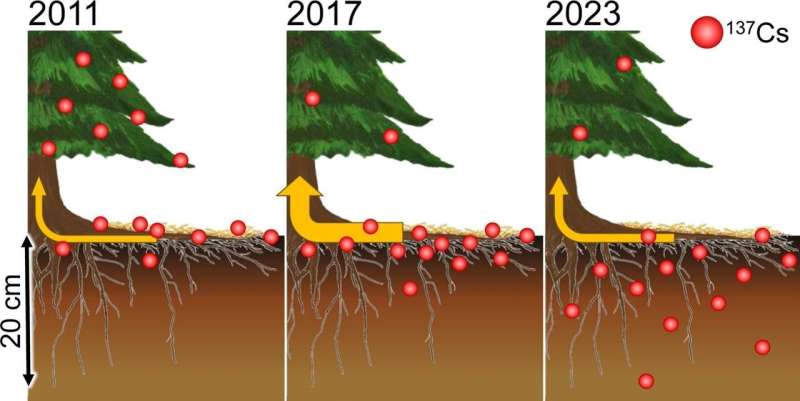This article has been reviewed according to Science X's editorial process and policies. Editors have highlighted the following attributes while ensuring the content's credibility:
fact-checked
peer-reviewed publication
trusted source
proofread
Forest monitoring reveals self-cleansing effect of radiocesium in ecosystem after Fukushima Daiichi plant accident

A forest monitoring survey conducted more than 13 years after the Fukushima Daiichi Nuclear Power Plant accident has revealed that the natural downward migration of radiocesium in soil exhibits a decontamination effect that reduces the air dose rate and radiocesium absorption by roots.
In the Hamadori (Pacific coast) area of Fukushima Prefecture, numerous efforts are underway to recover from the impacts of the Great East Japan Earthquake and Fukushima Daiichi Nuclear Power Plant accident.
Although some decontamination work, such as the removal of layers of litter (dead leaves), were conducted in part of the forest area, most of the area remained contaminated by radioactive cesium (137Cs). Therefore, there are persistent requests from citizens for forest decontamination.
However, using existing decontamination methods, the efficiency of reducing 137Cs today, more than 13 years after the accident, remains low, rendering the development of new forest decontamination methods crucial.
For the study, published in Science of The Total Environment, a research group at University of Tsukuba investigated 137Cs dynamics in the litter and soil layers and absorptive fine roots (<0.5 mm in diameter) in a cedar forest in the Yamakiya district of Kawamata Town, Fukushima Prefecture, from 2011 to 2023. Results show that the downward migration of 137Cs from the litter layer to the mineral soil surface occurred rapidly.
Furthermore, the 137Cs content of the soil increased over time, whereas that in the fine roots of cedar trees decreased since 2020. Specifically, the 137Cs content in fine roots at a soil depth of 0–2 cm, where fine roots are dense, decreased considerably because the downward migration of 137Cs in the soil caused a shift in the peak of the depth distribution of 137Cs in the soil from the depth distribution of roots.
Thus, the downward migration of 137Cs in the soil by even a few centimeters reduces 137Cs absorption by trees. This phenomenon can be regarded as the self-cleansing effect of the forest ecosystem. Here, the term self-cleansing refers to a reduction in radionuclide concentrations by natural processes.
After the Chernobyl nuclear power plant accident, self-cleansing effects, by which the 137Cs content is diluted by rainwater and incoming river water, were reported primarily in aquatic ecosystems such as rivers and oceans. However, such effects in forest ecosystems have received little attention.
Therefore, the evaluation of the self-cleansing effects presented in this study and their use as a new forest decontamination measure is expected to contribute to the resumption of the stagnant forestry industry in Hamadori.
More information: Junko Takahashi et al, Downward migration of 137Cs promotes self-cleaning of forest ecosystem by reducing root uptake of Japanese cedar in Fukushima, Science of The Total Environment (2024). DOI: 10.1016/j.scitotenv.2024.174010
Journal information: Science of the Total Environment
Provided by University of Tsukuba



















